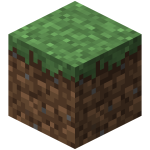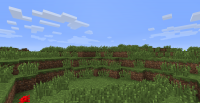Césped
| Tipo |
Bloque Sólido |
| Requerimientos |
Véase Crecimiento |
| Físicas |
No |
| Transparencia |
No |
| Iluminación |
No |
| Resistencia a explosiones |
3 |
| Dureza |
0,6 |
| Herramienta | |
| Renovable |
No |
| Apilable |
Sí (64) |
| Inflamable |
No |
| Primera aparición | |
| Otorga |
1 |
| Valor de datos |
dec: 02 hex: 2 bin: 10 |
| Nombre |
césped |
El césped es un bloque que se introdujo en el juego muy pronto. Usa 4 texturas: una de color gris para la parte superior, que luego se tinta al color correcto en concordancia con el bioma en el que se encuentre el bloque, una que es igual a la de la tierra en la parte inferior, una textura editada de la tierra con césped en la esquina superior de todas las caras, y una textura gris que relaciona la forma del césped en el lateral del bloque, que se tinta al color correcto dependiendo del bioma en el que se encuentre. Cuando se cubre de nieve, el lateral de la textura es blanco. En los mapas naturales, el césped aparece en la encima de mayoría de bloques de tierra que no tengan fluidos o bloques sólidos y opacos encima.
Cuando se rompen, los bloques de césped se comportan igual que la tierra, y de hecho sueltan tierra a no ser que se use el encantamiento Toque de Seda para ello. Si se rompen con una pala, el proceso es más rápido. Aunque el comportamiento se asemeja al de la tierra, al romper el césped hace un ruido distinto y demora un poco más de tiempo para romperlo.
Crecimiento
El césped crece de forma espontánea durante la generación del mapa. Después, el césped se puede expandir a bloques de tierra adyacentes. Que el césped se expanda sin la intervención del jugador, dependerá en gran medida del tiempo del día. Para que un bloque de tierra acepte césped en él, se requiere lo siguiente:
- The dirt block receiving grass must be within a 3×3×5 range of the source block where the source block is in the center of the second topmost layer of that range,
- The source block must have a light level of 9 or brighter directly above it,
- The dirt block must have a light level of at least 4 above it,
- Any block above the dirt block must not reduce light by 2 levels or more.
Light-reducing blocks include any opaque block, as well as lava, water, ice, and partially transparent blocks like stairs and single slabs. Grass blocks can grow under all other transparent blocks like glass, fences, torches, or pistons. Grass jumps directly from one block to a neighbor and is not affected by gaps or other blocks being "in the way". Grass blocks spread at random intervals and have an equal chance of spreading to any suitable dirt blocks that are in range. Because grass can spread as much as 3 levels downward, it tends to spread down slopes much faster than it spreads up them. Also due to this spreading 3 levels down regardless of obstructions, the player can later discover grass growing in dirt floored cellars or extremely shallow caves if the player previously lit them.
Harvesting grass blocks by hand or with most tools will drop a dirt block. However, grass blocks that retain the grass on top can be harvested by any tool with the Silk Touch enchantment. When mined with such a tool, a grass block will drop just like the same block in the Creative mode and can be placed in any valid location. This can be useful for creating grass patches in places where it doesn't naturally occur, such as underground, the middle of a desert, player made structures, or more exotic places like the Nether or the End. Once harvested with Silk Touch and the above requirements are met, grass blocks will spread normally in both the Nether and the End, though it does not occur naturally in either. Of course, dirt doesn't occur naturally in those places either, so it must also be brought in by the player in addition to the grass block.
Without using Silk Touch, the player can help grass spread by placing a trail of dirt blocks from a grass block to the patch of dirt where grass is desired. The process can take awhile, but it can be sped up by lighting the blocks so the grass also has a chance of spreading during the night. It can be sped up even further by placing dirt blocks on the sides and on top, leaving a space above each block. With this method grass can grow to more of the adjacent dirt blocks, increasing the odds of transfer.
Since Endermen can pick up some naturally occurring blocks, they can also unintentionally spread grass. An Enderman can pick up a grass block, teleport elsewhere in the map and place the grass block on or next to some dirt where it can spread if the above requirements are met. This can lead to rare occurrences where the player discovers grass growing inside caves or ravines that the player previously explored and lit.
Muerte
A Grass Block will die and change to dirt after a random time if covered by any block that reduces the light level above the grass block to 4 or below, including any opaque blocks, or the surrounding area is brought to sufficient darkness. Transparent blocks directly over grass can't kill the grass directly, if the surrounding area provides sufficient darkness, the grass will die.
For example, in direct sunlight with a light level of 15, grass will die with 4 or more water or ice blocks directly on top of it (assuming it isn't getting any extra light from the sides). In Moonlight, which is level 4, grass will die when covered by a single water or ice block.
Tilling a grass block with a hoe will convert it to a Farmland block, which can then revert to a dirt block from several causes, which can then return to grass.
Grass blocks also change to dirt when sheep "eat" them.
Uses
- Animals will occasionally spawn on grass blocks that have light level 9 or brighter in the space directly above. This is quite rare and requires that there be few other animals nearby. Most animals are instead created along with the terrain. See the spawn page for details.
- Passive mobs tend to wander towards grass blocks. They also wander towards light, but they ignore light over grass blocks and prefer them to any light levels below 10.
- Bone Meal used on Grass Blocks will grow tall Grass and Flowers.
- Sheep "feed" on grass blocks by turning them into dirt.
- Sheep regrow wool when they "eat" a grass block.
- Grass blocks can be used to make lawns, gardens or as a shade of green in pixel art that is on the ground.
- A growing or dying grass block can be detected by a BUD. Therefore, growth and death conditions can be used to create a redstone light sensor.
Historia
| Classic | ||
|---|---|---|
| Pre 0.0.9 (rd-132211) | Grass block was the second block in Minecraft, after Cobblestone. | |
| When first introduced, Grass block had its top side texture on all sides, resulting in "grass cubes"[1]: 30px | ||
| Pre 0.0.9 (rd-132328) | Grass blocks now have side textures. Also, the top texture was made brighter: | |
| 0.26 | Sheep would eat grass to regrow wool on their bodies, reverting it to dirt. Often, the grass would regrow just as quickly as sheep would eat it. | |
| 0.30 | Attempting to place grass blocks by means of hacking one's inventory in Classic Creative Multiplayer will cause the server to automatically kick the player. Due to Creative mode's lack of dynamic lighting, grass that is in shadow will eventually die and change to dirt. Grass in one's inventory used to have a green color on all sides of the block. | |
| Indev | ||
| January 26, 2010 | Placeable grass blocks were stored in chests for a short time, and when placed, no matter where, the grass would never die. The only way to kill the grass was to mine the block. | |
| Alpha | ||
| 1.2.0 | Before, grass blocks had a bright green top texture since Biomes didn't exist at that time, and when biomes were added in the Halloween Update, the color of the top of the Grass block now corresponds to whatever biome it is located in: | |
| Beta | ||
| 1.5 | ||
| 1.6 | Before, seeds could be harvested from grass blocks with a hoe. Seeds can now be harvested by destroying tall grass. | |
| 1.8 | Between Alpha 1.2.0 to now, Grass block had a different texture when obtained in the inventory (via an Inventory Editor or the /give command) or held by Endermen. The strange inventory texture appeared to have the side face on the top, as well, resulting in a bizarre 3D effect. | |
| It was not possible to legitimately obtain a Grass Block before this update with the introduction of Creative Mode. It was first obtainable in Survival Mode in 1.9Pre-4 when enchantments were added, and with Silk Touch destroying a Grass Block would give the actual block instead of Dirt, although you cannot pick up the block again with a normal tool after placing it yourself. | ||
| Lanzamiento oficial | ||
| 1.0.0 | 1.9pre5 | In this update, the top of Grass Block's and snowy Grass block's textures were slightly changed, to look more fitting with standard biomes and give it a darker look: 30px |
| The functionality of slabs has changed and will no longer revert grass blocks beneath it to dirt allowing grass to spread from underneath. | ||
| 1.4.2 | 12w38a | Grass now has new sounds when being placed and walked on. |
| Pocket Edition Alpha | ||
| 0.1.0 | Added grass blocks. | |
| Edición consola | ||
| TU1 | Added grass blocks. | |
| Edición Pi | ||
| 0.1.1 | Added grass blocks. | |
Curiosidades
- Grass blocks and dirt blocks changing between each other is a very common cause of chunk updates.
- A grass block has become the favicon for Minecraft.net, and is the icon for the Minecraft launcher and the Pocket Edition app.
- In MineCon's goodie-bags, grass, along with the creeper, diamond, and the Player (Steve?), were given as foldable decorations.
- Grass was the second block to be added into Minecraft, after Cobblestone.
- TNT and Sponge sounds for walking on, placing the block, and destroying it are the same as the grass block.
- If you reach the edge of the rendered world (i.e. the edge of a chunk, where the adjacent chunk has not yet appeared), the edge line of grass blocks will adopt the "default" grass hue, until the adjacent chunk appears, at which point it will assume the correct colour (this is more easily noticed in swampland biomes).
Véase también
Error en la cita: Existen etiquetas <ref>, pero no se encontró una etiqueta <references />




